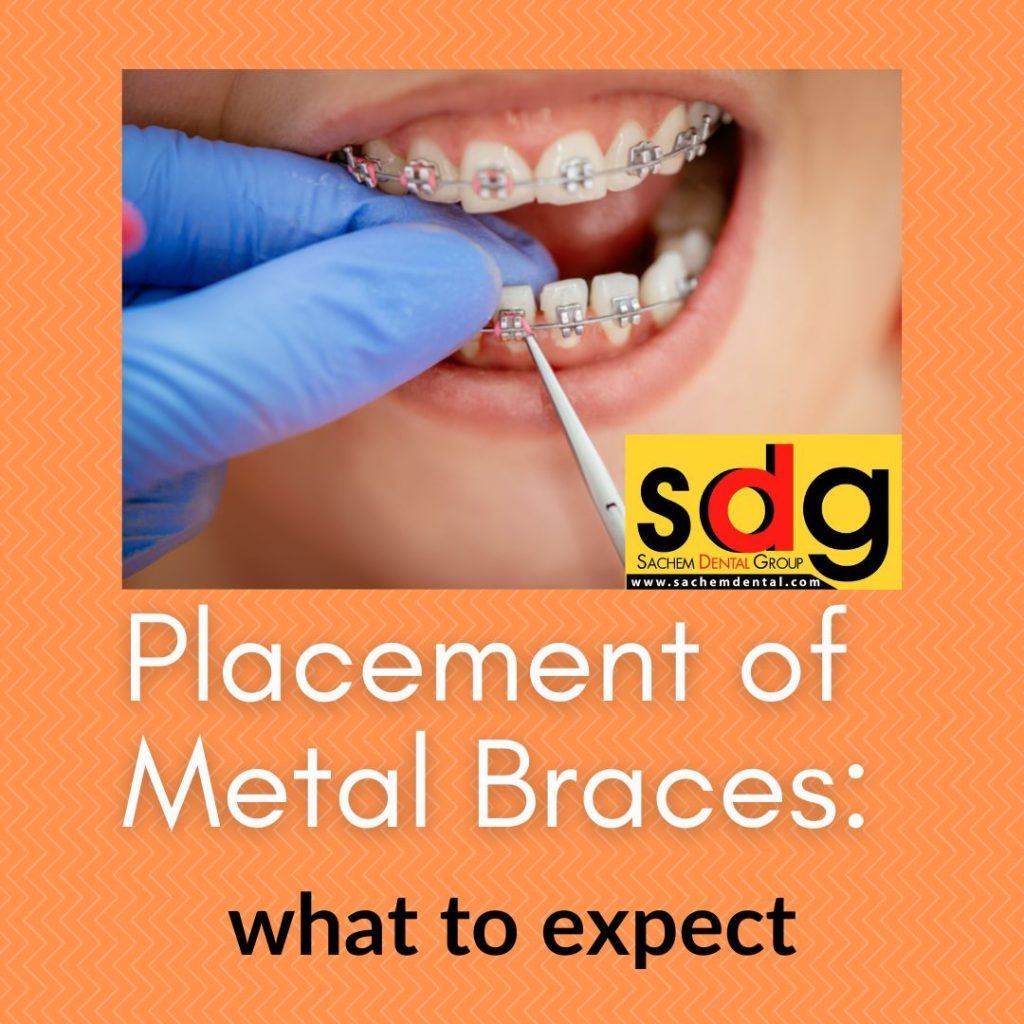
Having braces put on can be a little confusing, especially if you’re unfamiliar with the process. However, the more you know about it ahead of time, the better prepared you’ll be when the moment comes to walk into your dentist’s office and get fitted with braces. To help, we’ll cover what to expect when you go in for your first appointment once the big day arrives.
The Different Parts of Braces (Orthodontics)
In general, orthodontic brackets are connected with an arch wire. The arch wire is the thin, U-shaped wire that spans from one side of your smile to the other; it’s what’s responsible for physically moving your teeth when you wear braces. As such, our Long Island dentists will change the arch wire out at periodic intervals to keep your teeth moving properly.
The brackets are the smaller, square-shaped pieces that are attached to each respective tooth. There are two main types of brackets – clear and metal. Clear brackets are made out of a ceramic-like material, while metal brackets are stainless steel. Each type of bracket is specifically designed for different orthodontic purposes and should be used accordingly.
How Brackets are Attached to Teeth
Brackets are bonded onto the teeth with a special type of adhesive. Your dentist or orthodontist will mark and space the brackets in the areas of the mouth where they will be most effective. Then those surfaces are slightly etched to roughen the outermost layer of enamel. Next, a bonding agent is applied and special tools are used to hold the small bracket and place it in a certain spot.
Brackets are usually bonded onto the teeth without any discomfort, but some patients feel a little uncomfortable as their mouth will be open for a fairly long period of time. Fortunately, a small prop is used to rest your jaw and keep your lips apart, so that you can relax your muscles in the meantime.
Some brackets are even held onto the tooth with a “loop” or “band” that goes around the tooth, like a belt. This type of bracket is usually limited to back teeth (molars).
Attaching the Braces Archwire to Your Brackets
To attach the archwire to the brackets, we’ll use a small rubber band (called an elastic) to hold it in place. To attach them properly, we line up the band over the bracket and then use a small tool that stretches the elastic. Once the elastic is placed over the band and bracket, the tool is released, and the elastic contracts around the wire, holding it into place.
Elastics come in a variety of colors and shades, so you can choose one or more at a time. Since the elastics are changed out regularly, many people like to be festive with the current holiday or show school spirit around game season. Clear elastics are also available, for a more discreet appearance. And if you don’t love a certain color that you picked, that’s ok, they’re changed out about once every 6-8 weeks.
Other Orthodontic Appliances That May Need to Be Installed With Braces
A few other orthodontic appliances may be necessary in addition to traditional orthodontic wires and brackets. Such as:
Space Maintainers or Band and Loops:
A space maintainer is sometimes necessary if a tooth is lost to create an open space for teeth to come through. These appliances are temporary and prevent the adjacent teeth from drifting inward. They are removed once the tooth erupts.
Springs on Braces:
If teeth need to be spread further apart to address crowding, a small spring may be attached to the brackets or wire in that space. the small spring creates gentle pressure at either end, encouraging those teeth to move away from one another.
Herbst Appliances:
A Herbst appliance is worn with the goal of correcting mild crowding of upper and lower teeth by shifting the upper and lower jaw into a different direction, such as the lower jaw more forward.
Palatal Expanders:
A narrow palate (roof of mouth) can interfere with tooth placement, speech, and orthodontic tooth movement. Our Long Island dentists may recommend a temporary expander to help create extra space by widening the roof of your mouth.
What to do if a Bracket Falls Off
If one of your brackets falls off and you can’t get to our Suffolk County dentist right away, don’t panic. The bracket isn’t your tooth’s permanent position. It just helps to guide it into place. A dentist or orthodontist can put everything back to normal as soon as possible.
In the meantime, check to see if anything needs to be removed from your tooth so that you don’t accidentally bite down on the bracket. If you’re able to clip the elastic with a pair of nail trimmers, you can do so. Otherwise, if the bracket isn’t interfering with anything, just leave it be and call our Long Island office.
Be sure to keep some orthodontic wax on hand in case something breaks off. Since the bonding agents are temporary, this may happen time to time, especially if you eat something crunchy or sticky. Cover any sharp or pointed areas with the orthodontic wax to minimize irritation to the inside of your mouth.
The Day of Your Braces Installation
Your mouth may be a little sore on the date your braces are installed (and a few days after) because of the new pressure placed on your teeth. This is completely normal! We recommend taking Motrin or ibuprofen as directed before your appointment and as needed for the next 2-3 days. It can also help to have some lip balm on hand, as your lips may feel a little dry after having braces installed.
Braces in Long Island
If you’re considering orthodontic treatment for your child, teen, or yourself, we encourage you to call the multi-specialty general dentists of Sachem Dental. We offer in-house orthodontic options for patients of all ages. Is it time to invest in your smile? Contact us today!
